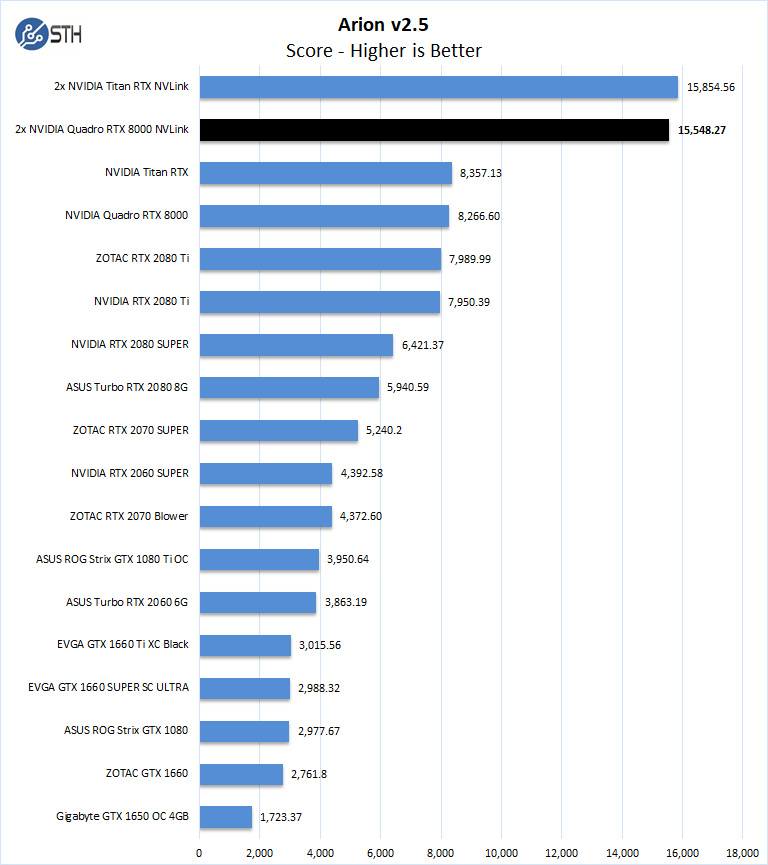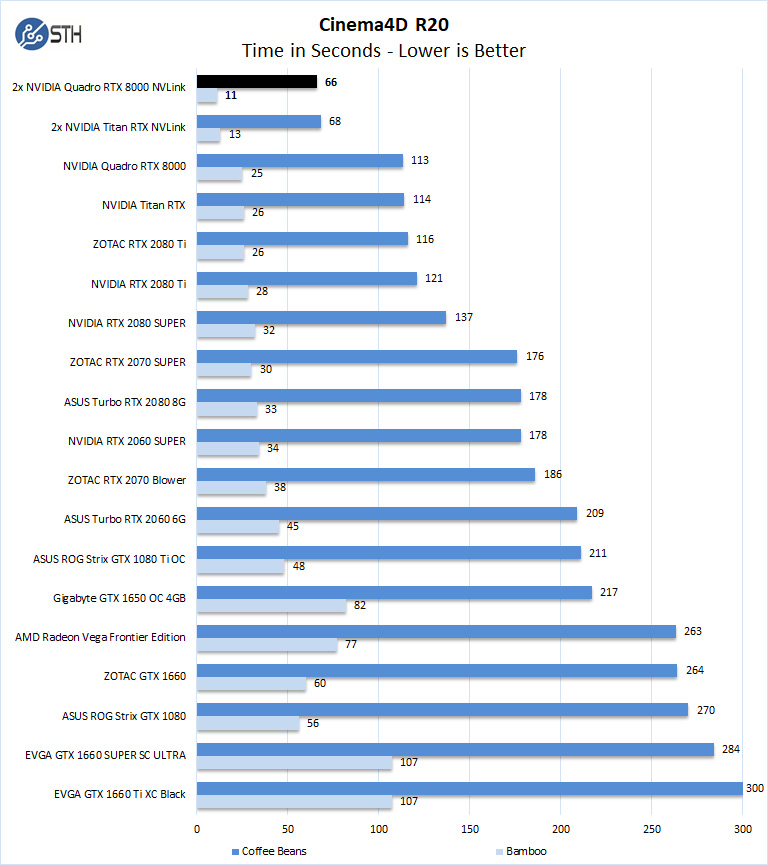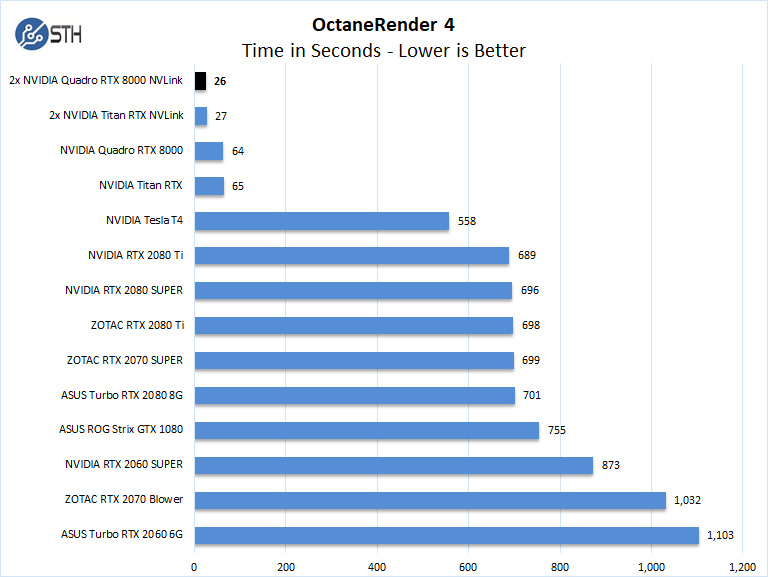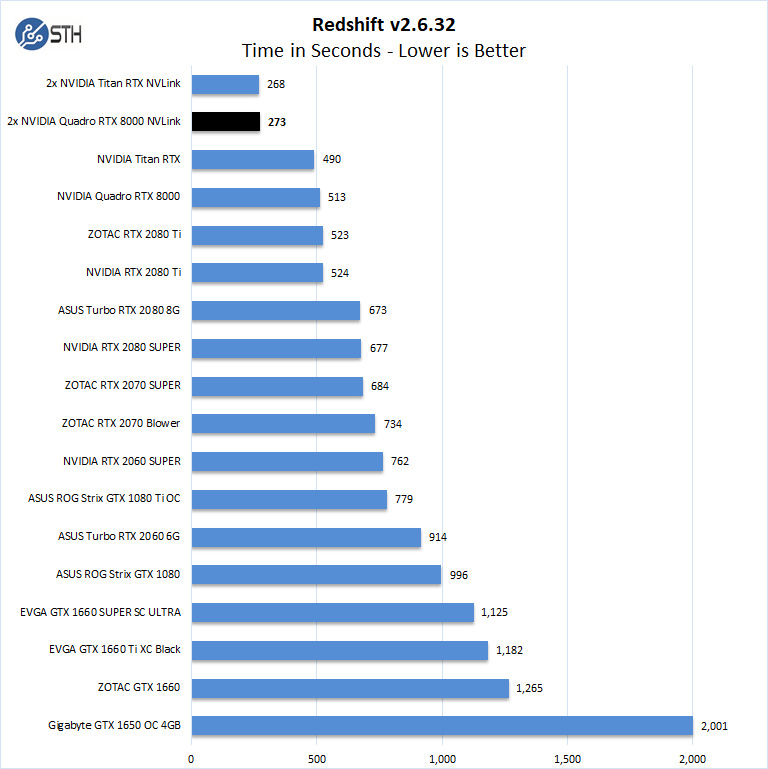NVIDIA Quadro RTX 8000 NVLINK Rendering Related Benchmarks
Next, we wanted to get a sense of the rendering performance of the NVIDIA Quadro RTX 8000 NVLINK configuration.
Arion v2.5
Arion Benchmark is a standalone render benchmark based on the commercially available Arion render software from RandomControl. The benchmark is GPU-accelerated using NVIDIA CUDA. However, it is unique in that it can run on both NVIDIA GPUs and CPUs.
Download the Arion Benchmark from here. First-time users will have to register to download the benchmark.

Like our first set of benchmarks, there is but a slight difference between the Quadro RTX 8000 NVLINK and Titan RTX NVLINK.
MAXON Cinema4D 3D
ProRender is an OpenCL based GPU renderer which is available in MAXON’s Cinema4D 3D animation software. A fully functional 42-day trial version is available for downloaded from the MAXON website here. Note: Even after expiration, the trial can still be used to measure render times.

With a two-second difference, the Quadro RTX 8000 NVLINK ranks ahead of the Titan RTX NVLINK.
OctaneRender 4
OctaneRender from Otoy is an unbiased GPU renderer using the CUDA API. The latest release, OctaneRender 4, introduces support for out of core geometry. Octane is available as a standalone rendering application, and a demo version is available for downloaded from the OTOY website here.

Again, we see a one-second difference, and the Quadro RTX 8000 NVLINK ranks ahead of the Titan RTX NVLINK.
Redshift v2.6.32
Redshift is a GPU-accelerated renderer with production-quality. A Demo version of this benchmark can be found here.

NVIDIA Quadro RTX 8000 NVLINK finishes 5 seconds behind the Titan RTX NVLINK, which has better cooling.
Next, we will have 3DMark results before moving onto power consumption, thermals, and our final thoughts.




Why is the Radeon VII not in the comparison, William? It would be competitive in some tests.
Emerth – we do not have one to test and they are discontinued. As a result, it is a low priority. We may look at the Radeon Pro version, but that just started shipping.
Can it run fortnite at 60 fps though?
I would really love to see some testing with this card for VGPUs in VMWare :P
@Jeremy likely it can simulate running Fortnite at 60FPS.
About AIDA64 GPGPU Part1 graph of Page 3, My Titan Black’ Double-Precision FLOPS value is 1842 when “Double precision” is enabled on NVIDIA control panel → Manager 3D settings. Default is disabled! when disabled, the score plummets to 256.7 GFLOPS and it matches the graph value.
It is better to show the better score, their double precision circuit is fully utilized IMO
OctaneRender 4 does not take advantage from quadro or Titan cards, rtx 2080ti result should be comparable to rtx 8000, SLI should just halve the time.
https://render.otoy.com/octanebench/results.php?v=4.00&sort_by=avg&filter=&singleGPU=1
I guess something went wrong.
yamamoto wrote: About AIDA64 GPGPU Part1 graph of Page 3, My Titan Black’ Double-Precision FLOPS value is 1842 when “Double precision” is enabled on NVIDIA control panel.
This is a very important point.
When reading through the review I was about to ignore this card as yet another AI GPU unsuited for doing science. Now your comment has me wondering which other cards treated here suffered a similar methodological problem with double precision arithmetic.
@Eric
Maybe other Kepler GPUs such as GTX Titan or Quadro K6000 are affected
I have a Titan V, there is no “Double Precision” menu item on NVIDIA Control Panel on this GPU and its AIDA64 Double-Precision score is 6283 GFLOPS. It is cost effective solution for some scientific calculation IMO.
Can this gpu beat the titan v in case of gaming and editing .